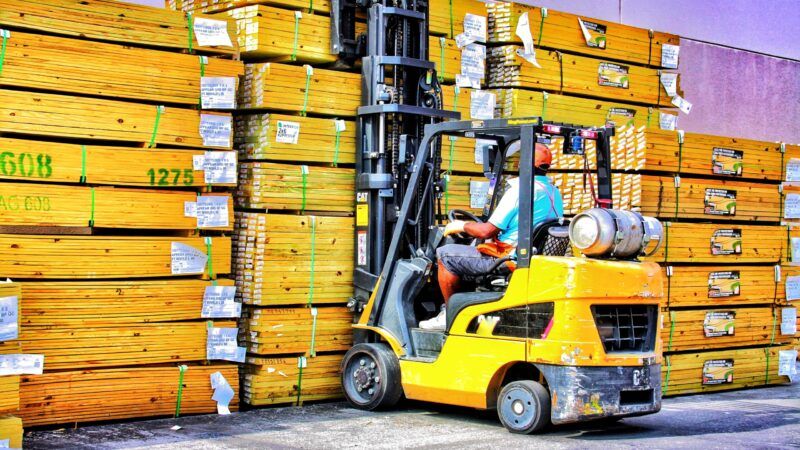Lumber Is Crazy Expensive Right Now. Biden Is About To Make It Worse.
The Commerce Department is planning to hike tariffs on Canadian lumber from about 9 percent to more than 18 percent.

Amid surging lumber prices that are already adding an average of $36,000 to the construction cost of new homes, the Biden administration is moving forward with plans to double tariffs on lumber imported from Canada.
The Commerce Department announced on Friday that it was taking the first step toward hiking so-called "anti-dumping tariffs" on Canadian lumber from an average rate of 8.99 percent in 2018 to 18.32 percent for 2019. Yes, 2019. If approved through what is likely to be a lengthy review process, the tariffs would apply retroactively to purchases made for the past two years. That means American importers could be on the hook for millions of dollars in taxes they didn't even know they would owe—taxes that will likely be passed down the supply chain in the form of higher prices.
That's only the first bit of insanity here. Anti-dumping tariffs, in theory, are meant to cancel out what's seen as unfair subsidies for foreign competitors to American companies. They are supposed to be deployed in order to prevent import prices from becoming so low that they threaten domestic producers—even though there's really nothing terrible about low prices for imports.
But lumber prices are anything but low right now. In fact, they are up over 250 percent in the past year, and the price per thousand feet of board lumber just hit an all-time high.
How bad are things? So bad that lumber has become a meme.
I'm behind on lumber pricing: do these pallets make me a millionaire or pic.twitter.com/WvI88yqNzZ
— Myles Udland (@MylesUdland) April 24, 2021
If the Biden administration goes ahead with the plan to hike tariffs, it will be the latest bit of industrial protectionism emanating from Washington that will be paid for by Americans. While the domestic timber and lumber industries are thrilled at the prospect of artificially inflated prices for imports from Canada—the largest foreign supplier, by far, of wood into the United States—the higher tariffs will almost certainly translate into higher prices for consumers and wood-using industries.
"If the administration's decision to double tariffs is allowed to go into effect, it will further exacerbate the nation's housing affordability crisis, put even more upward pressure on the price of lumber, and force millions of U.S. home buyers and lumber consumers to foot the bill for this ill-conceived protectionist action," said Chuck Fowke, chairman of the National Association of Home Builders, in a statement.
The current price surge for lumber—like similar increases for many other goods—has been triggered by a shortage of supply as pandemic-closed sawmills have been slow to reopen even while demand for lumber has steadily climbed, driven by robust demand for new housing. Import taxes aren't to blame for this mess, but they certainly aren't helping.
Even the Trump administration, which counter-productively hiked tariffs on everything from steel and aluminum to washing machines and other consumer goods, realized that much. Trump approved a lumber tariff hike in 2017, but his administration cut those duties in late 2020 amid concerns about the rising price of lumber.
High and rising lumber prices aren't just a problem for home-builders and others who need to buy large supplies of wood. Some manufacturers are concerned that tariffs are helping to drive inflation across the entire economy by artificially jacking up prices for many commodities, The Wall Street Journal reported last week.
With prices skyrocketing, the best thing the federal government could do is sweep aside impediments to supply chains. Instead, the administration is erecting new barriers which will protect domestic industries.
Unfortunately, as Scott Lincicome, a Cato Institute senior fellow for trade issues, points out, the law guiding the U.S. anti-dumping tariff process explicitly forbids consideration of how new duties might impact consumers.
That, in a nutshell, is the problem with just about all tariffs. If you ignore how higher taxes on goods might harm individuals and businesses, you're not really seriously considering the consequences—you're just doing what the beneficiaries of that policy want. Policy making cannot be disconnected from economic reality, no matter how much politicians might want it to be.
Denying the reality of how tariffs work doesn't always look as buffoonish as the Trump administration often made it. Sometimes it just appears to be rote bureaucratic activity. But the result is the same, and Americans are going to keep paying the price until the Biden administration learns that.


Show Comments (138)